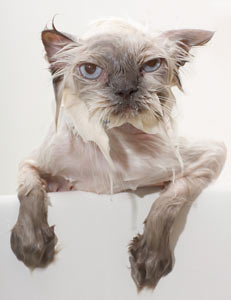Why Do Cats Hate Water?

Most people who have shared their lives with cats have found out that our feline friends are not crazy about baths. In fact, some of them get downright angry about that tub full of water, and they won't hesitate to claw their way out of the situation. This begs the question: Why do cats hate water?
Cats Like to Experience Life on Their Terms
It may surprise you to find your kitty dipping his paw into his water bowl and then shaking it out, climbing on the counter to explore a leaky faucet, or actually begging you to turn on a tap so he can drink right out of it. Some cats even put their heads in the water and play a bit. Why would your cat do these things, but hate to be bathed?
Cats don't like surprises. They like to approach experiences with their own timing and ability to change their mind at any time. When you grab your cat and stick him into a tub full of water, he hasn't had time to decide if it's something that's safe or not. His fight or flight mechanism may kick in, causing him to wildly try to escape, or he may yowl in frustration and anger through the entire bath.
Cats are Sensitive to Smells
Cats can smell the chemicals in tap water much more acutely than humans can. Some cats don't even like to drink tap water because of their sensitivity to its odor.
Cats' Coats Get Heavy When Wet
The top layer of a cat's coat generally has some water-resistance. However, if the coat is completely drenched, it becomes quite heavy. This probably makes the cat feel like he isn't as maneuverable or fast as usual. Cats like to know that they can get out of a situation any time they need to, so feeling heavy and slow is an unwelcome sensation.
Cats Get Cold Easily
Cats maintain a higher body temperature than humans, and it's harder for them to get and stay warm. Being draped in heavy, wet fur is cold.
Water Was Not a Big Part of Most Cats' Evolution
Most domestic cats descend from felines that lived in arid regions. Water simply may not have been a big part of their evolutionary consciousness. Some cats that came from watery areas do seem to like water. In fact, the Turkish Van is known for loving to swim and play in water. These cats come from an area of Turkey with a large lake, and cats there would swim out to meet the fishing boats that their humans worked on. They ate fish and kept rodents off of the boats. There are also some jungle cats that fish for food. These cats will sit on the edge of water waiting for a meal, and some even sit in the water.
Can You Teach Your Cat to Enjoy Bath Time?
It may be possible to help some cats learn not to hate baths. Following are some steps for acclimating your cat to water. During every step, use praise and treats to reward your cat for participating.
- If possible, start exposing your cat to baths when he is a kitten. The earlier an idea or event is introduced to a cat, the more likely they are to accept it and maybe even enjoy it.
- First, get your cat used to the enclosure that you intend to use to bathe him. This may be a tub, sink, or plastic wash bin. Place toys and catnip in the area, and encourage him to get in and check them out.
- Once your cat is comfortable playing in the bath space, fill it with an inch of water and throw in some toys.
- Do this several times over a few weeks until your cat is comfortable splashing in the water a bit.
- When it is time to try a real bath, place a mat or towel on the bottom of the tub or sink so your cat feels more stable.
- Use the least amount of restraint necessary to keep your cat in the tub.
- Have everything that you'll need ready so you can get done as quickly as possible.
- Stay calm yourself. If you approach the bath matter-of-factly, your cat will be more likely to stay composed too.
-
Use a towel to dry your cat as well as you can when the bath is finished, and provide a nice warm place for him to curl up and finish drying.
- Microfiber towels are very absorbent and are a great option for drying your cat.
-
If you absolutely must use a blow-dryer, keep it on low (cool or cold), and don't get closer than 4-6 inches from your cat. Keep the blow-dryer moving and use your hand to ruffle the fur while also judging how warm it's getting. Blow dryers can easily burn cats.
- The first time you try to use a blow dryer, first turn it on while you are across the room from your cat, and watch how he reacts. If he acts frightened, you won't be able to use a dryer.
- If he does not act alarmed, slowly move closer to your cat.
- Only blow dry your cat if he allows you to do so without acting afraid.
Don't use human shampoos, flea shampoos, or medicated shampoos unless your veterinarian recommends one. Use a mild shampoo made for cats.
- Human skin has a different pH than cats' skin. Human shampoos can be too drying to cats and may cause skin conditions as a result.
- Medicated shampoos should only be used if a skin problem is diagnosed. Otherwise, they can cause new skin issues.
- Flea shampoos kill the fleas that are on the pet but do not keep new fleas from jumping on. Flea products can be very specific as to the age and species that they are used on. It can be very dangerous if dog products are used on cats, so flea products should only be used on the recommendation of your veterinarian.
If you can't get your cat to accept baths, the good news is that our feline friends shouldn't need them too often. Cats are usually fastidious groomers and also tend to stay out of messy situations. If your cat suddenly stops grooming well, it may indicate that he isn't feeling well. See a veterinarian if this occurs. If your cat does get into something sticky or stinky and won't tolerate a bath, here are a few options:
- Waterless shampoo: Your veterinarian or pet store can provide you with one of these great products that doesn't require rinsing. Just make sure it's made for cats.
- Sponge bathing: A warm sponge or washcloth can be used to clean most superficial messes from your kitty's fur.
- Make an appointment with a groomer: Find a groomer who works with cats and let them bathe your buddy for you.
- Regular brushing: If your cat is prone to dander, prompting you to want to bathe him often, institute a program of regular brushing. Most cats love being brushed, it's a soothing activity for humans, and it will help distribute oils across the fur that will decrease dander.
With some patience and understanding on your part, your cat can learn to love baths. Or maybe tolerate them. Or maybe still not accept them at all, but at least you'll understand why.
You May Also Like These Articles:
Why Do Cats Do the Slow Eye Blink? : It's a Kitty "Eye Love You"!
Notice: Ask-a-Vet is an affiliated service for those who wish to speak with a veterinary professional about their pet's specific condition. Initially, a bot will ask questions to determine the general nature of your concern. Then, you will be transferred to a human. There is a charge for the service if you choose to connect to a veterinarian. Ask-a-Vet is not manned by the staff or owners of CatHealth.com, and the advice given should not delay or replace a visit to your veterinarian.





